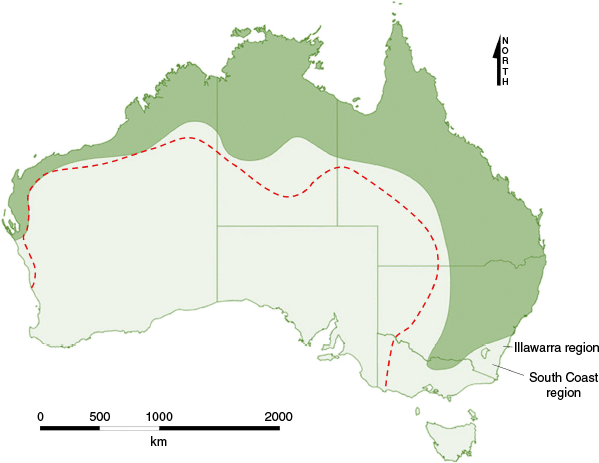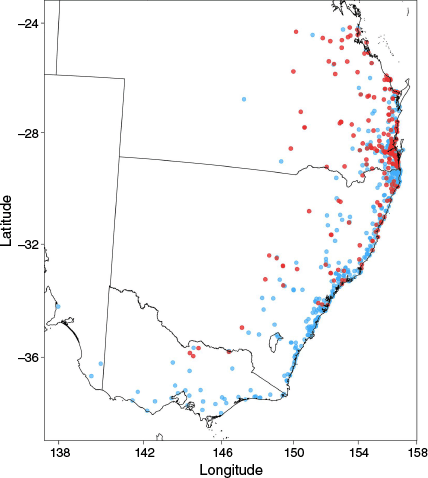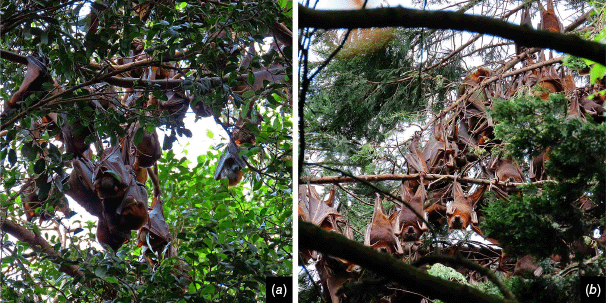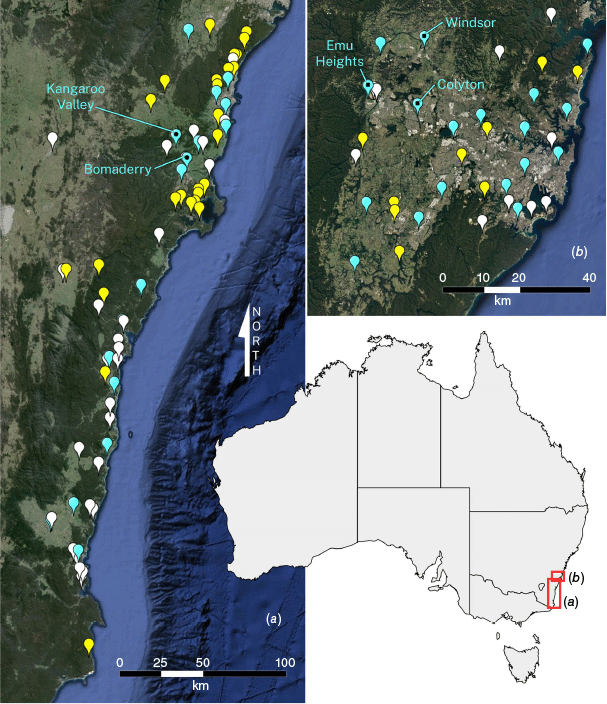Recent roosting of little red flying-foxes (Pteropus scapulatus, Pteropodidae) at two sites in the South Coast region of New South Wales, Australia
Matthew Mo A * , Kylie Coutts-McClelland B , Trista Kyriacou C , Janine Davies D , Gerardine Hawkins C , Samara Wehmeyer C , Lorraine Oliver B , Samantha H. Yabsley E , Jessica Meade E and Justin A. Welbergen
A * , Kylie Coutts-McClelland B , Trista Kyriacou C , Janine Davies D , Gerardine Hawkins C , Samara Wehmeyer C , Lorraine Oliver B , Samantha H. Yabsley E , Jessica Meade E and Justin A. Welbergen  E
E
A
B
C
D
E
Abstract
We report observations of temporary colonies of little red flying-foxes (Pteropus scapulatus) occurring at two roost sites on the South Coast of New South Wales, a region in which roosting by this species is rarely observed. The colonies persisted at these locations for at least 25 days during February and March 2024 and consisted of fluctuating numbers of little red flying-foxes, up to 27,000 individuals during an inspection at one site. Concurrent inspections of 40 of the 61 other known flying-fox roosts in the South Coast and adjacent Illawarra regions confirmed that little red flying-foxes were not present at those sites. However, the species was concurrently present in three grey-headed flying-fox (Pteropus poliocephalus) roosts in Sydney, ~110–125 km away, and in one roost in the lower Hunter region, ~215 km away. We also report on two earlier instances of little red flying-foxes at roost sites in the South Coast region.
Keywords: Chiroptera, flying-fox colonies, management implications, megabat, monitoring, New South Wales, nomadism, Old World fruit bats, Pteropodidae, Shoalhaven district, species distribution, Yinpterochiroptera.
Introduction
Four species of flying-fox (genus Pteropus) occur on the Australian mainland (Hall 1987; Hall and Richards 2000), of which the little red flying-fox (P. scapulatus) is the most distinguishable with its smaller body size (310–600 g body mass, 125–156 mm forearm length; Welbergen et al. 2023). Compared with other Australian flying-foxes, it occurs further inland (Lumsden and Bennett 1995; Young and Ford 2000; Timmiss et al. 2021), which corresponds with its diet being primarily nectivorous and only scarcely frugivorous (Prociv 1983; Churchill 1998; Bradford et al. 2022). In fact, the little red flying-fox is one of the widest-ranging flying-fox species in the world, potentially distributed over an area exceeding 3.5 million km2 (Sinclair et al. 1996), a range second-only in size to that of the Indian flying-fox (P. medius, formerly P. giganteus) (Tsang 2020). The little red flying-fox is believed to subsist in arid and semiarid regions by following river systems in search of flowering trees (Richards 1983; Welbergen et al. 2023). Their smaller size, with greater surface-to-volume ratio, is likely advantageous for heat exchange (Conenna et al. 2021), with field accounts showing little red flying-foxes to have a higher thermal threshold at which heat stress responses are observed than for sympatric flying-fox species (Bartholomew et al. 1964; Welbergen et al. 2008). However, as the least studied of the Australian mainland flying-fox species, its extent of occurrence is unclear, which has implications for managing contentious issues, including human–wildlife conflict (Currey et al. 2018; Roberts et al. 2021; Mo et al. 2023a), zoonotic dynamics (Kung et al. 2015; Jemison 2017) and our understanding of the interactions of little red flying-foxes with the threatened grey-headed flying-fox (P. poliocephalus).
Delineating exact limits for the geographic range of the little red flying-fox is a fraught task. Traditionally, scientific texts (e.g. Hall 1987; Eby 1995; Hall and Richards 2000; Currey et al. 2018) and field guides (e.g. Birt et al. 2013) have generalised the species’ distribution as the largest amount of area over which the species has been sighted (Fig. 1). However, on rare occasions, little red flying-foxes have also been found further into westerly areas of Queensland, New South Wales (NSW) and Victoria, and further south along the Western Australian coastline (Hall 1987; Birt et al. 2013). Alternatively, some scientific texts (e.g. Macdonald et al. 2020) and field guides (e.g. Menkhorst and Knight 2011) have generalised the species range in a more conservative approach (Fig. 1), limiting it to only areas where the species is regularly observed in roosts (Fig. 2). These generalisations then exclude regions such as the coastal areas and ranges of NSW south of Sydney, the Australian Capital Territory and much of Victoria. Although restrictive, this approach portrays the species range to be more reflective of ‘typical’ situations, on the principle that even though excluded areas may have occasional reports of individuals (usually injured individuals reported to wildlife carers), there are generally little to no confirmed reports of the species roosting.
Different generalisations of the little red flying-fox (Pteropus scapulatus) geographical range. The green shading is the conservative distribution shown in Macdonald et al. (2020) that was limited to the range in which the species is regularly observed in roosts. The red broken line represents the more inclusive boundaries shown in most scientific texts (e.g. Hall 1987; Eby 1995; Hall and Richards 2000; Timmiss et al. 2021) and field guides (e.g. Birt et al. 2013).

Map of known flying-fox (Pteropus spp.) roosts monitored under the National Flying-fox Monitoring Program within the geographical distribution of the grey-headed flying-fox (Pteropus poliocephalus). Roosts in which little red flying-foxes (Pteropus scapulatus) have been recorded by the program prior to this study are shown in red.

Little red flying-foxes have been observed in Sydney only intermittently (Puddicombe 1981; Parry-Jones and Augee 1991) and observations of roosting further south of the NSW coastline have been limited to anecdotal reports from a landholder of occasional individuals on Comerong Island in the Shoalhaven district (Robinson 1985). These individuals were reportedly roosting among grey-headed flying-foxes, the species typically associated with the roost on Comerong Island (Mills 1988; Eby 1991). Our study reports on recent observations of colonies of little red flying-foxes integrated into two existing grey-headed flying-fox roosts in the Shoalhaven district, with broader geographical context drawn from synchronous inspections of other flying-fox roosts in the wider South Coast and adjacent coastal regions. We also report two earlier observations of the species at roost locations in the South Coast region that have not been published previously.
Observations
Recent observations
On 14 February 2024, one of the authors (KC-M) observed colonies of little red flying-foxes within two existing grey-headed flying-fox roosts in the Shoalhaven district (Fig. 3). The total number of flying-foxes at both roosts were manually counted as part of the routine monitoring for the National Flying-fox Monitoring Program (Australian Department of Climate Change, Energy, the Environment and Water 2024); however, little red flying-foxes were densely clustered on this observation date (Fig. 3b), preventing accurate counting of this species. At one roost, situated in Bomaderry within the Illowra Wetland and Rainforest Reserve (34.8589°S, 150.6008°E), approximately 3500 little red flying-foxes and 10,561 grey-headed flying-foxes were counted. Thus, little red flying-foxes comprised approximately 25% of the mixed-species colony. At a second roost, situated in Kangaroo Valley on a private property site (34.7355°S, 150.5303°E), approximately 1430 little red flying-foxes and 2805 grey-headed flying-foxes were counted. Thus, little red flying-foxes comprised approximately 33% of this mixed-species colony. The two roosts are approximately 15 km apart. Both were inspected by one of the authors (JD) 2 days prior on 12 February 2024, which confirmed that little red flying-foxes were not present at either roost at that time.
Little red flying-foxes (Pteropus scapulatus) in the Bomaderry, Brinawarr Street roost (a) and Kangaroo Valley, Moss Vale Road roost (b). Photographs by Matthew Mo.

Concurrent with these observations, flying-fox roosts across Australia were synchronously inspected as part of the National Flying-fox Monitoring Program, which provides wider surveillance of flying-fox roost occupancy to complement the above observations. As part of this program, observers (including authors MM, KC-M, and JD) inspected 40 of the 61 other known flying-fox roosts in the South Coast region1 and the adjacent Illawarra region (Fig. 4a). The remaining roosts were not prioritised because of expected low probabilities of flying-fox occurrence (on the basis of those sites having no known occupancy for 3 years or more), and subsequently were not inspected because of time constraints.2 None of these 40 roosts contained little red flying-foxes. However, colonies of little red flying-foxes were observed by one of the authors (SHY) in three existing grey-headed flying-fox roosts in the Sydney metropolitan area situated in Colyton (33.7782°S, 150.8059°E), Emu Heights (33.7296°S, 150.6539°E), and Windsor (33.6070°S, 150.8263°E), ~110–125 km north of Kangaroo Valley. These sites were 3 of 28 flying-fox roosts that were inspected by observers during February 2024 for the National Flying-fox Monitoring Program of the 37 known flying-fox roosts in the Sydney metropolitan area (Fig. 4b). Notably, there was also a colony of little red flying-foxes in an existing grey-headed flying-fox roost in Blackalls Park (33.0079°S, 151.5888°E) in the lower Hunter region (Dominic Edmonds, Lake Macquarie City Council, pers. comm). This roost is ~215 km north of Kangaroo Valley and ~100–115 km north of the three Sydney roosts.
Map of known grey-headed flying-fox (Pteropus poliocephalus) roosts in (a) the South Coast and Illawarra regions and (b) the Sydney metropolitan area, showing roosts that little red flying-foxes (Pteropus scapulatus) were observed in with location labels. Roost occupancy by grey-headed flying-foxes during 14–17 February 2024: occupied (blue), vacant (white), and not inspected (yellow).

On 17 February 2024, one of the authors (MM) re-inspected the Bomaderry and Kangaroo Valley roosts and undertook manual counts of little red flying-foxes. In the Bomaderry roost, little red flying-foxes were not clustered, and 269 individuals were counted, representing only 7% of the number of individuals estimated 3 days earlier. In the Kangaroo Valley roost, most of the little red flying-foxes were densely clustered (Fig. 3b), and we estimated there were perhaps 27,000 individuals present, which would represent an 1800% increase from the estimate undertaken 3 days earlier. On 19 February 2024, counts of little red flying-foxes at both roosts were repeated (KC-M), with 2600 individuals estimated for Bomaderry and 3300 individuals estimated for Kangaroo Valley. These estimates were also vastly different from earlier estimates. The colony sizes of grey-headed flying-foxes were not counted at either roost on these observation dates because of time constraints. Species ratios were therefore not able to be determined for either roost for these observation dates.
Little red flying-foxes were observed to be present at both the Bomaderry and Kangaroo Valley roosts for at least 25 days following their initial discovery on 14 February 2024. The last observed date for both roosts was 10 March 2024. One of the authors (JD) inspected the Bomaderry roost on 11 March 2024 and did not observe any little red flying-foxes among the grey-headed flying-foxes. An inspection the following day by two of the authors (KC-M and JD) also did not detect the species and confirmed that only grey-headed flying-foxes were present. One of the authors (TK) inspected the Kangaroo Valley roost on 25 March 2024 and likewise observed that only grey-headed flying-foxes were present.
Earlier anecdotal observations
To our knowledge, little red flying-foxes have been observed in roosts in the South Coast region only on two previous occasions, apart from the report relating to Comerong Island published in Robinson (1985). Anecdotally, a colony was known to have formed temporarily near the township of Termeil (exact location unknown), approximately 70 km south of Bomaderry, in ~2005 (Wildlife Rescue South Coast, unpubl. data). The second instance occurred on 1 February 2020 at the Kangaroo Valley roost, during which more than 8300 grey-headed flying-foxes were killed during an extreme heat event (Mo et al. 2022). Among the recovered carcasses, two dead adult male little red flying-foxes were identified by two of the authors (TK and JD). For an indication of ambient temperatures experienced at that event, the maximum temperature recorded at the Nowra RAN Air Station automatic weather station, approximately 24 km from Kangaroo Valley, for that day was 42.0°C.
Discussion
On the basis of the little red flying-fox not typically roosting in coastal regions south of Sydney (Menkhorst and Knight 2011; Macdonald et al. 2020), any reports of roosting colonies in the South Coast and Illawarra regions would be noteworthy. The colonies of little red flying-foxes reported here were particularly novel in terms of the length of time the colonies remained and the numbers of individuals involved, with the species being observed to remain in the region for at least 3 weeks and at one point numbering ~27,000 individuals.
Although counts were undertaken only on three observation dates, we detected extraordinary fluctuations even within the span of 6 days from 14 February to 19 February 2024. In Bomaderry, there was a sharp decrease in numbers within 3 days (from ~3500 to 269 individuals), which was followed by a similarly sharp increase 2 days later (to ~2600 individuals). In Kangaroo Valley, there was a very steep increase within 3 days (from ~1430 to ~27,000 individuals), followed by a dramatic reduction 2 days later (to ~3300 individuals). Furthermore, the combined counts of individuals across both colonies on each date were remarkably different, just under 5000 individuals on 14 February 2024, compared with more than 27,000 individuals on 17 February 2024 and approximately 5900 individuals on 19 February 2024. With such differences in abundance, fluctuations within each roost cannot be simply attributed to individuals moving between these two roosts. The sheer mobility of the little red flying-fox is particularly highlighted in recent research, indicating that the species is more mobile than other Australian flying-foxes, with satellite-tracked individuals accumulating annual journeys of 3782–6073 km compared with annual journeys of 2268–2564 km and 1427–1887 km in grey-headed and black flying-foxes respectively (Welbergen et al. 2020). Furthermore, the same study found little red flying-foxes exhibiting higher rates of daily colony turnover, estimated at approximately 36%, compared with 18% and 12% in grey-headed and black flying-foxes respectively. These findings, and our observations of fluctuating abundance between the two colonies, reflect the highly nomadic nature of the species (Franklin et al. 2017).
Causes for the little red flying-fox being rare in the South Coast region of NSW are poorly understood. The species’ infrequency in this region seems contrary to its environmental adaptability elsewhere demonstrated in its occurrence across a broad gradient of tropical to temperate climatic zones (Sinclair et al. 1996). Furthermore, little red flying-foxes seem to be unrestricted by the occurrence of other flying-fox species, commonly occurring sympatrically in multi-species roosts throughout the coastal regions of their range (Lunn et al. 2021; Mo et al. 2023b; Welbergen et al. 2023). The observed presence of colonies persisting in Bomaderry and Kangaroo Valley over a minimum 3-week period indicates that there were sufficient nectar resources in the Shoalhaven district to attract and then support the species over that timeframe. During that time, mass flowering of red bloodwoods (Corymbia gummifera) was evident over large expanses from the Blue Mountains district, west of the Sydney metropolitan area (Eli Bendall, pers. comm.), to the Illawarra (Gavin Phillips, pers. comm.) and South Coast regions (MM, pers. obs.). Roost occupancy of grey-headed flying-foxes in the South Coast region usually follows a seasonal pattern of reduced numbers of individuals over the cooler months (with vacancy of the entire region in some years), except when there is mass blossoming in diet species during those periods (Parry-Jones 1985; Mo et al. 2020). These observations show dramatic fluctuations in food availability in this region, although this should not perturb little red flying-foxes with their high level of mobility (Welbergen et al. 2020).
The occurrence of little red flying-foxes has important localised management implications. Little red flying-foxes tend to be more active and skittish in roosts than other flying-fox species, which can exacerbate the impact of noise experienced by adjacent communities (M. Mo, pers. obs.). As members of the public may not observe species differences, the addition of little red flying-foxes to an existing flying-fox roost can contribute to increased community tensions and implications for community support of the regularly occurring flying-fox species. Furthermore, their roosting behaviour is often characterised by several dozen individuals densely clustered on the same branch and often clinging to each other (Nelson 1965). The combined weight of many individuals clustered together can cause entire tree limbs to break (Hall and Richards 2000). The combination of little red flying-foxes clustering densely and exhibiting higher levels of activity in roosts can also cause defoliation of roost trees in a matter of weeks, compared with years from roosting by other flying-fox species (Eby 1995; Hall and Richards 2000). Thus, the occurrence of little red flying-foxes can severely affect the roosting habitat of other species. In the case of the Shoalhaven district, the grey-headed flying-fox that is listed as Vulnerable under federal (Commonwealth of Australia 2015) and New South Wales state legislation (NSW Scientific Committee 2001), as well as under the IUCN Red List of Threatened Species (Eby et al. 2021), is implicated by the presence of little red flying-foxes causing defoliation to roost habitat and contributing to community perceptions of larger overall colony sizes. Visitations of little red flying-foxes to this district and the wider South Coast region of NSW is therefore of interest from a standpoint of both a conservation and human–wildlife issues.
Acknowledgements
The National Flying-fox Monitoring Program is a joint initiative of the Australian Government and state and territory environmental agencies in NSW, Queensland, Victoria, South Australia and the Australian Capital Territory, supported by numerous participants that undertake the on-ground monitoring and the Commonwealth Scientific and Industrial Research Organisation. During our study, the following people attended flying-fox roosts in the South Coast, Illawarra and Sydney regions: Ailee-Lynn Calderbank, Alexandra Seddon, Bec Williams, Ben Haynes, Beth Mott, Cally Collins, Chelsea Costello, Courtney Fink, Dave Harrington and the team of volunteers that monitor the Centennial Park roost in Sydney, David Henry, Deb Little and the Wolli Creek Preservation Society volunteers, Elizabeth Cameron, Emmett Weatherford, Enhua Lee, Evelyn Osborne, Fred Ford, Geoff Francis, Haley Henning, Hugh Pitty and the Friends of Glebe Wetlands volunteers, Jordan James, Kristie King, Michael Ellison, Nicholas Carlisle, Nicole James, Peter Nichols, Pierre Vignal Atherton, Ray Giddins, Richard Gough, Robyn Kesby and the team of volunteers that monitor the Panboola Wetlands roost in Pambula, Rohan Bilney, Ryan Wall, and Sue-Ellen Smith. Dominic Edmonds advised of little red flying-foxes occurring in Blackalls Park. Eli Bendall and Gavin Phillips contributed observations of mass-flowering of red bloodwoods.
References
Australian Department of Climate Change, Energy, the Environment and Water (2024). Monitoring flying-fox populations. Available at https://www.dcceew.gov.au/environment/biodiversity/threatened/species/flying-fox-monitoring
Bartholomew, G. A., Leitner, P., and Nelson, J. E. (1964). Body temperature, oxygen consumption and heart rate in three species of Australian flying-foxes. Physiological Zoology 37(2), 179-198.
| Crossref | Google Scholar |
Bradford, M., Venz, M., Bell, K. L., Hogan, L., Smith, G. C., Eby, P., Eyre, T. J., McKeown, A., Vanderduys, E., MacDonald, S., and Westcott, D. (2022). The diet of a specialist nectarivore in Australia: the little red flying-fox (Pteropus scapulatus, Pteropodidae). Austral Ecology 47, 619-628.
| Crossref | Google Scholar |
Conenna, I., Santini, L., Rocha, R., Monadjem, A., Cabeza, M., and Russo, D. (2021). Global patterns of functional trait variation along aridity gradients in bats. Global Ecology and Biogeography 30, 1014-1029.
| Crossref | Google Scholar |
Currey, K., Kendal, D., van der Ree, R., and Lentini, P. E. (2018). Land manager perspectives on conflict mitigation strategies for urban flying-fox camps. Diversity 10, 39.
| Crossref | Google Scholar |
Eby, P. (1991). Seasonal movements of grey-headed flying-foxes, Pteropus poliocephalus (Chiroptera: Pteropodidae), from two maternity camps in northern New South Wales. Wildlife Research 18, 547-559.
| Crossref | Google Scholar |
Eby, P., Roberts, B., Pennay, M., and Welbergen, J. A. (2021). Pteropus poliocephalus. The IUCN Red List of Threatened Species. Available at https://www.iucnredlist.org/species/18751/22085511
Franklin, D. C., Barnes, T. A., and Prout, K. (2017). Large, temporary camps of the little red flying-fox at Herberton. North Queensland Naturalist 47, 32-42.
| Google Scholar |
Hall, L. S. (1987). Identification, distribution and taxonomy of Australian flying-foxes (Chiroptera: Pteropodidae). Australian Mammalogy 10, 75-79.
| Crossref | Google Scholar |
Hall, L. S. (2002). Management of flying-fox camps: what have we learnt in the last twenty-five years? In ‘Managing the Grey-headed Flying-fox as a Threatened Species in New South Wales’. (Eds P. Eby, D. Lunney) pp. 215–224. (Royal Zoological Society of New South Wales: Sydney, NSW, Australia) 10.7882/FS.2002.054
Jemison, M. (2017). Communication considerations for One Health: the influence of media framing on representations of a human-bat disease conflict in the Australian print media. Australian Zoologist 38, 505-517.
| Crossref | Google Scholar |
Kung, N. Y., Field, H. E., McLaughlin, A., Edson, D., and Taylor, M. (2015). Flying-foxes in the Australian urban environment: community attitudes and opinions. One Health 1, 24-30.
| Crossref | Google Scholar | PubMed |
Lumsden, I. F., and Bennett, A. F. (1995). Bats of a semi-arid environment in south-eastern Australia: biogeography, ecology and conservation. Wildlife Research 22, 217-239.
| Crossref | Google Scholar |
Lunn, T. J., Eby, P., Brooks, R., McCallum, H., Plowright, R. K., Kessler, M. K., and Peel, A. J. (2021). Conventional wisdom on roosting behavior of Australian flying-foxes: a critical review, and evaluation using new data. Ecology and Evolution 11, 13532-13558.
| Crossref | Google Scholar | PubMed |
Macdonald, S. L., Bradford, M., McKeown, A., Vanderduys, E., Hoskins, A., and Westcott, D. (2020). Camp site habitat preferences of the little red flying-fox (Pteropus scapulatus) in Queensland. Australian Journal of Zoology 68, 234-253.
| Crossref | Google Scholar |
Mo, M., Roache, M., Lenson, D., Thomson, H., Jarvis, M., Foster, N., Oliver, L., Oliver, D. L., and Bentley, J. (2020). Congregations of a threatened species: mitigating impacts of grey-headed flying-fox Pteropus poliocephalus camps on the Batemans Bay community. Australian Zoologist 41, 124-138.
| Crossref | Google Scholar |
Mo, M., Roache, M., Davies, J., Hopper, J., Pitty, H., Foster, N., Guy, S., Parry-Jones, K., Francis, G., Koosmen, A., Colefax, L., Costello, C., Stokes, J., Curran, S., Smith, M., Daly, G., Simmons, C., Hansen, R., Prophet, D., Judge, S., Major, F., Hogarth, T., McGarry, C., Pope, L., Brend, S., Coxon, D., Baker, K., Kaye, K., Collins, L., Wallis, M., Brown, R., Roberts, L., Taylor, S., Pearson, T., Bishop, T., Dunne, P., Coutts-McClelland, K., Oliver, L., Dawe, C., and Welbergen, J. A. (2022). Estimating flying-fox mortality associated with abandonments of pups and extreme heat events during the austral summer of 2019-20. Pacific Conservation Biology 28, 124-139.
| Crossref | Google Scholar |
Mo, M., Coutts-McClelland, K., Wilson, V., Haering, R., Oliver, L., Bell, L., and Lunney, D. (2023a). Managing the grey-headed flying-fox as a threatened species in New South Wales two decades on: contentious issues for horticulturalists and communities. Australian Zoologist 42, 871-896.
| Crossref | Google Scholar |
Mo, M., Meade, J., Price, J., Maisey, J., and Welbergen, J. A. (2023b). Synchronous abortion events in the grey-headed flying-fox (Pteropus poliocephalus). Pacific Conservation Biology 29, 110-118.
| Crossref | Google Scholar |
Nelson, J. E. (1965). Behaviour of Australian Pteropodidae (Megachiroptera). Animal Behaviour 13, 544-557.
| Crossref | Google Scholar | PubMed |
Parry-Jones, K. (1985). Winter flying-fox colonies in southern NSW. Australian Zoologist 22, 5-6.
| Crossref | Google Scholar |
Parry-Jones, K. A., and Augee, M. L. (1991). The diet of flying-foxes in the Sydney and Gosford areas of New South Wales, based on sighting reports 1986–1990. Australian Zoologist 27, 49-54.
| Crossref | Google Scholar |
Prociv, P. (1983). Seasonal behaviour of Pteropus scapulatus (Chiroptera: Pteropodidae). Australian Mammalogy 6, 45-46.
| Crossref | Google Scholar |
Roberts, B. J., Mo, M., Roache, M., and Eby, P. (2021). Review of flying-fox camp dispersal attempts in Australia. Australian Journal of Zoology 68, 254-272.
| Crossref | Google Scholar |
Robinson, N. H. (1985). Bats of the Illawarra region. Australian Zoologist 22, 1-4.
| Crossref | Google Scholar |
Sinclair, E. A., Webb, N. J., Marchant, A. D., and Tidemann, C. R. (1996). Genetic variation in the little red flying-fox Pteropus scapulatus (Chiroptera: Pteropodidae): implications for management. Biological Conservation 76, 45-50.
| Crossref | Google Scholar |
Timmiss, L. A., Martin, J. M., Murray, N. J., Welbergen, J. A., Westcott, D., McKeown, A., and Kingsford, R. T. (2021). Threatened but not conserved: flying-fox roosting and foraging habitat in Australia. Australian Journal of Zoology 68, 226-233.
| Crossref | Google Scholar |
Tsang, S. M. (2020). Pteropus giganteus (errata version published in 2020). The IUCN Red List of Threatened Species. Available at https://www.iucnredlist.org/species/18725/194134899
Welbergen, J. A., Klose, S. M., Markus, N., and Eby, P. (2008). Climate change and the effects of temperature extremes on Australian flying-foxes. Proceedings of the Royal Society B 275, 419-425.
| Crossref | Google Scholar | PubMed |
Welbergen, J. A., Meade, J., Field, H. E., Edson, D., McMichael, L., Shoo, L. P., Praszczalek, J., Smith, C., and Martin, J. M. (2020). Extreme mobility of the world’s largest flying mammals creates key challenges for management and conservation. BMC Biology 18, 101.
| Crossref | Google Scholar | PubMed |
Young, R. A., and Ford, G. I. (2000). Bat fauna of a semi-arid environment in central western Queensland, Australia. Wildlife Research 27, 203-215.
| Crossref | Google Scholar |
Footnotes
2 The authors acknowledge that flying-foxes are known to return to roost sites that have not been occupied for periods extending over several years (Hall 2002; Westcott et al. 2011), and that ideally roosts are inspected to confirm presence or absence of flying-foxes irrespective of recent periods of vacancy.
2 The authors acknowledge that flying-foxes are known to return to roost sites that have not been occupied for periods extending over several years (Hall 2002; Westcott et al. 2011), and that ideally roosts are inspected to confirm presence or absence of flying-foxes irrespective of recent periods of vacancy.


